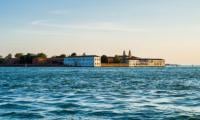The summer monsoon is considered a source of much-awaited relief from the scorching heat, but for some Pakistani urbanites, it appears to be losing its charm as extreme urban flooding becomes an increasingly common phenomenon.
This year, multiple neighbourhoods in the megacity of Lahore became the first target of severe inland flooding during the monsoon as windstorms and heavy downpours hit the city, taking at least 11 lives. With the climate crisis worsening, Pakistan must take rapid and drastic measures to combat the challenge of urban flooding head-on and reduce its impacts on communities.
In recent times, the approach of developing green streets, buildings and spaces to prevent the worst consequences of urban flooding has gained much traction. ‘Green streets’ can include several elements of blue-green infrastructure (BGI), including vegetative buffer strips and lawns, stormwater planters, tree trenches, stormwater bump-outs, detention and retention tanks, pervious pavements, and gravel trenches to allow water to percolate into the ground.
Vegetative buffer strips are dense growths of vegetation that increase water infiltration and evaporation; stormwater planters are vegetated planters installed in the sidewalk area that have an inlet at the street level and allow stormwater from sidewalks and streets to flow into them. Stormwater tree trenches include a series of trees embedded in catchments and linked to an underground infiltration structure; and stormwater bump-outs are vegetated extensions of the street curbs (sidewalk edge) that allow stormwater from streets and sidewalks to flow into them through inlets.
Detention tanks include underground systems to store runoff temporarily while retention tanks permanently store water. Stormwater collected in retention tanks can be recycled for purposes like irrigating gardens or flushing toilets; pervious pavements are paths with a porous surface to allow water to infiltrate through them, and gravel trenches include narrow channels filled with stones to allow stormwater to escape into the subsoil gradually.
‘Green buildings’ can include multiple elements of BGI, including green and blue roofs, rainwater harvesting systems, and downspouts. Green roofs consist of a growing medium (like soil) and vegetation over a waterproofing membrane, while blue roofs consist of a flow restriction device to hold water back during the storm event, along with a roof drain to allow the excess water to overflow into it.
Additionally, downspouts are vertical pipe attachments for carrying rainwater from a gutter or rooftop to a drain or ground; and rainwater harvesting systems help capture and store rainwater from the rooftop, such as by connecting the vertical pipes from rooftops to storage containers on the ground. Besides green streets and buildings, parks and green spaces, in general, help prevent flooding by stopping stormwater runoff and absorbing or filtering the rainwater. There are myriad benefits to incorporating these solutions, such as the low cost associated with installing them or their ability to perform multiple functions in a spatial area.
In Pakistan, the importance of green spaces has been increasingly recognized in recent years, and measures have been undertaken to revive the country’s vegetation and conserve the existing protected areas, particularly under the ‘ten billion tree tsunami programme’. The intent of the city and local community managers to enhance the uptake of BGI also appears visible.
For instance, the Capital Development Authority (CDA) has mandated that Islamabad residents install rainwater harvesting systems in houses, while the Lahore Development Authority (LDA) requires new high-rise buildings to install green roofs.
There is still a long way to go until BGI is incorporated widely in Pakistani cities to prevent stormwater runoff, even within formally planned and relatively green neighbourhoods. For instance, what do you see around you if you inhabit or drive across any such neighbourhood? There could be numerous green spaces, but those are not equally distributed across the spatial extent of an area.
Planters may rarely be seen installed in the sidewalk area and vegetated bump-outs formed along the street curbs, but without enough thought put into establishing inlets to direct the stormwater from streets into them. People may also see a series of trees planted linearly but not converted into tree trenches as a flooding mitigation strategy. Additionally, limited residential, office and commercial buildings have well-established rainwater harvesting systems or features of green or blue roofs.
A lack of planning and implementation on this front could be attributed to several challenges, such as growing pressures from urbanisation, scarcity of experts, lack of stakeholder coordination, absence of required policies, or insufficient awareness about BGI benefits. Extensive outreach efforts to communicate BGI benefits can stimulate stakeholders’ behavioural change and have the greatest impact in addressing other barriers because ‘where there is a will, there is a way.’
It is also vital that all interventions involving BGI give due attention to the deprived urban communities that suffer the disproportionate impact of flooding by virtue of inhabiting low-lying areas, living in houses made of inexpensive materials, or lacking access to institutional services, among other factors.
Rethinking how our buildings, streets, and cities are built to combat the adverse effect of urban flooding is an earnest necessity, and the sooner we recognize this, the better.
The writer is a research assistant at the Centre for Aerospace & Security Studies (CASS), Islamabad. She can be reached at: cass.thinkers@casstt.com















